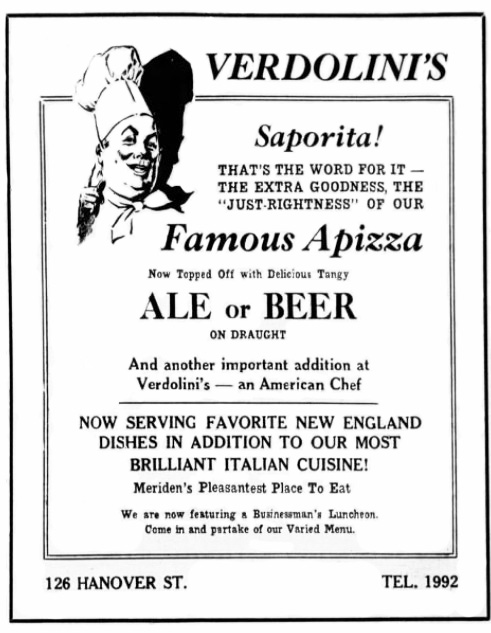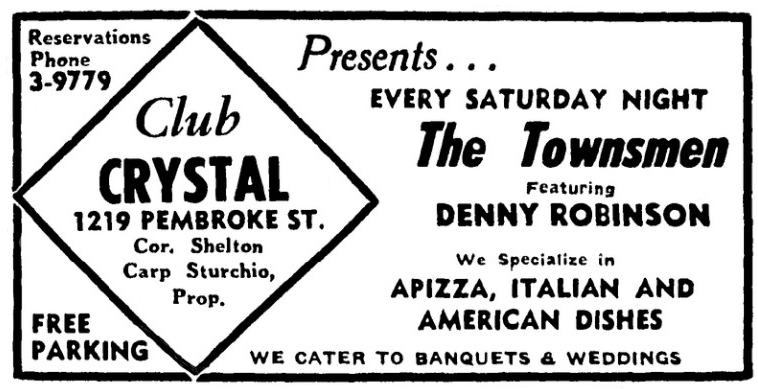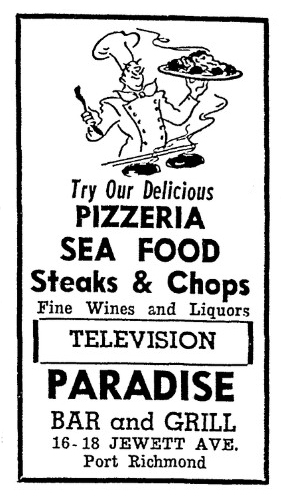Driving around Connecticut a while back I noticed signs with the unfamiliar terms “lapizza” and “apizza.” Occasionally since then I’ve wondered what accounted for the deviation from the commonplace word “pizza.”
Thanks to a recent round of fundraising on Connecticut Public Television, when they featured showings of Pizza, A Love Story, I found out why pizza was spelled that way. Watching the show, I heard the word apizza pronounced – repeatedly – for effect. Can you say ah-BEETS? That pronunciation is Neapolitan dialect, a simplification of la pizza. New Haven CT is hailed as today’s apizza center of the U.S. by its dedicated fans who probably would refuse to even enter a pizza chain’s parking lot.
In fact, it’s impressive that in 1978, when Pizza Hut had expanded to over 3,000 units nationwide, none was listed in New Haven’s City Directory. However, there were at least 31 pizza places in that city then, ten of them with apizza as part of their name. One of the pizza restaurants in New Haven was that of Fancesco “Frank” Pepe, initially a baker, who started making pizza in 1925. [1960s postcard shown at top of page] Today Pepe’s Pizzeria Napoletana is a small New England chain that has won many awards.
Although the word apizza came into common usage in advertisements in Connecticut newspapers in the 1930s – not just in New Haven but also Bridgeport, Meriden, and other cities – it remains in use today in many of the state’s Italian restaurants. I haven’t run across any descriptions of the Connecticut apizza of earlier days, but it’s unlikely that it was the cheese-delivery vehicle that most Americanized pizza has become. In the early 20th century Neapolitan pizza was described as a somewhat puffy, foldable crust typically topped with cooked tomatoes, grated cheese, oregano, and/or anchovies.
From the start in Connecticut and a few other parts of the Northeast, as well as California, pizza was take-out food, often bought at a bakery. But after Prohibition ended, it expanded into casual eating spots in Connecticut cities. Many of its purveyors ran taverns or other night spots, some of which featured it only on weekends. [below, Club Crystal, Bridgeport, 1940s] It was more of a snack than a meal, something to enjoy with friends. Beer was the favorite liquid accompaniment. As Meriden CT restaurant owner Vincent Verdolini put it in 1939, “beer to a lover of la pizza is like whipped cream to strawberry shortcake.”
Until the 1950s, most apizza consumers were Italian-Americans, many of them workers in Connecticut’s factories. Happily for them, pizza was inexpensive (in 1940, roughly 25¢ for small ones and 45¢ for large) and sellers delivered to workplaces. Early advertisements aimed at Italian speaking customers appeared in Italian-language newspapers such as La Sentinella in Bridgeport.
As I searched for the history of apizza in Connecticut, I happened upon another name for pizza, one that really surprised me because its meaning has shifted: pizzeria. Now a common name for a pizza parlor, at one time it was a word for pizza itself, as is evident in the advertisement for “delicious pizzeria, 25¢” at Frieda’s in Asbury Park NJ in 1936, shown above, or at the Paradise Bar and Grill on Staten Island in 1947 below.
For several decades restaurant chains have dominated the pizza market, making it all the more interesting that apizza, the word and the food, has survived.
© Jan Whitaker, 2022

















 It's great to hear from readers and I take time to answer queries. I can't always find what you are looking for, but I do appreciate getting thank yous no matter what the outcome.
It's great to hear from readers and I take time to answer queries. I can't always find what you are looking for, but I do appreciate getting thank yous no matter what the outcome.



I ate pizza the first time in Chicago, IL, 70 years ago, flat dough with a bunch of spices thrown over it, no cheese or tomato sauce. Does anyone else remember those first pizzas?
Loving this. Appreciate what you do. Culinary teacher in the World’s many Cuisines.
You are my Culinary Paul Harvey; after your posts then we know the ‘rest of the story’!! Lol
Thank you, thank you, Sandra!
Whereas most trade show conventions are eager to have attendees, the International Pizza Convention charges for admission and vets journalists who write about pizza. Pizza is more than a historical artifact, even to this day.
In Central New Jersey from the 1950’s to the ‘80’s, say from Princeton to Philly, Pizza was colloquially known as a “tomato pie”.
I’d narrow the geography of tomato pie more, just to Mercer County (Trenton and environs). I grew up in a Philly suburb in South Jersey, and only learned of the alternate name for pizza when I worked in Trenton during college in the 70s. I would say “tomato pie” as a synonym for pizza is unknown in the Philadelphia sphere of influence.
You may have me there. I grew up in Hightstown and went to Rider College (now University). Your Mercer County triangulation, is, as memory serves me, more than likely correct.